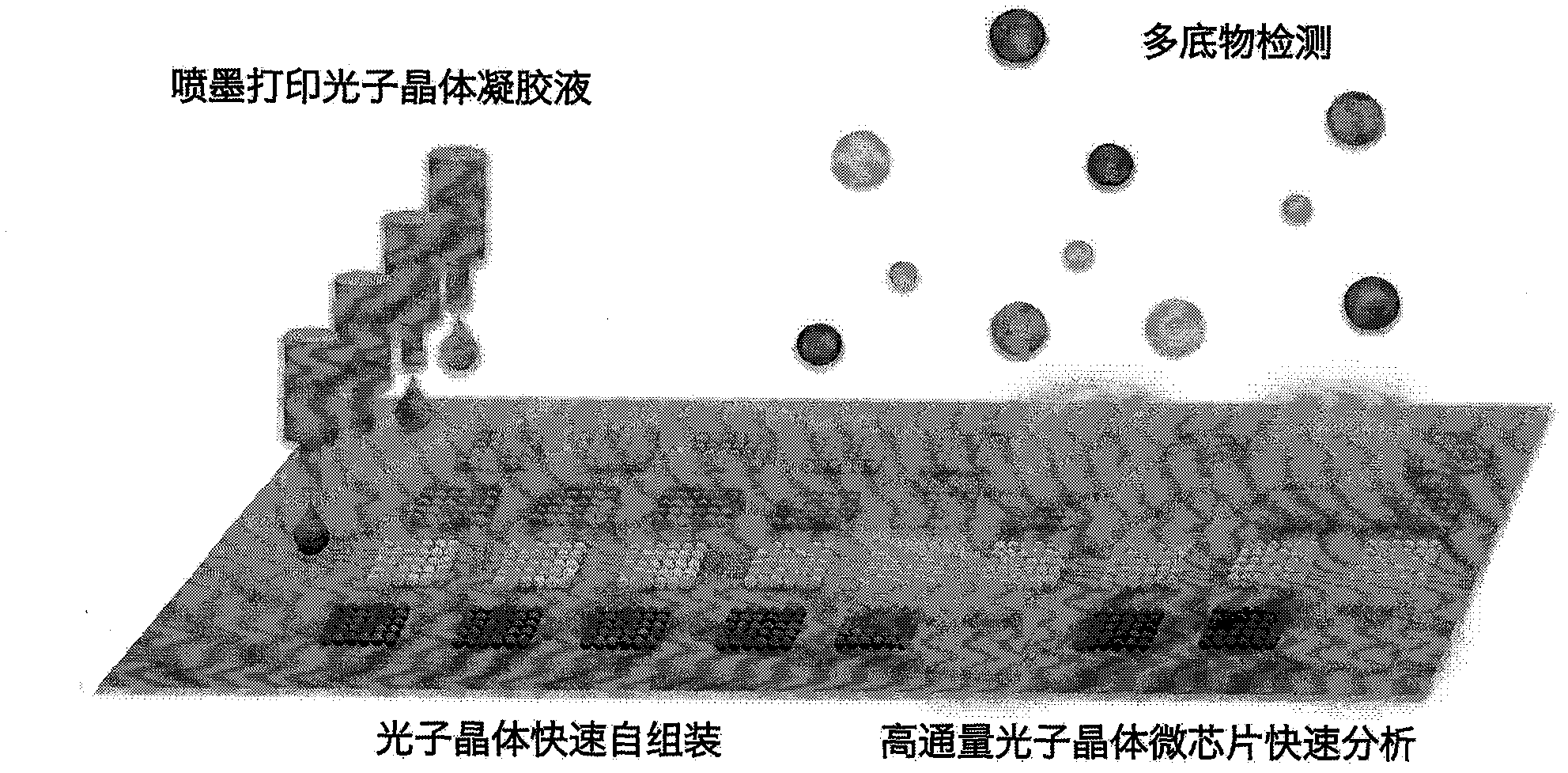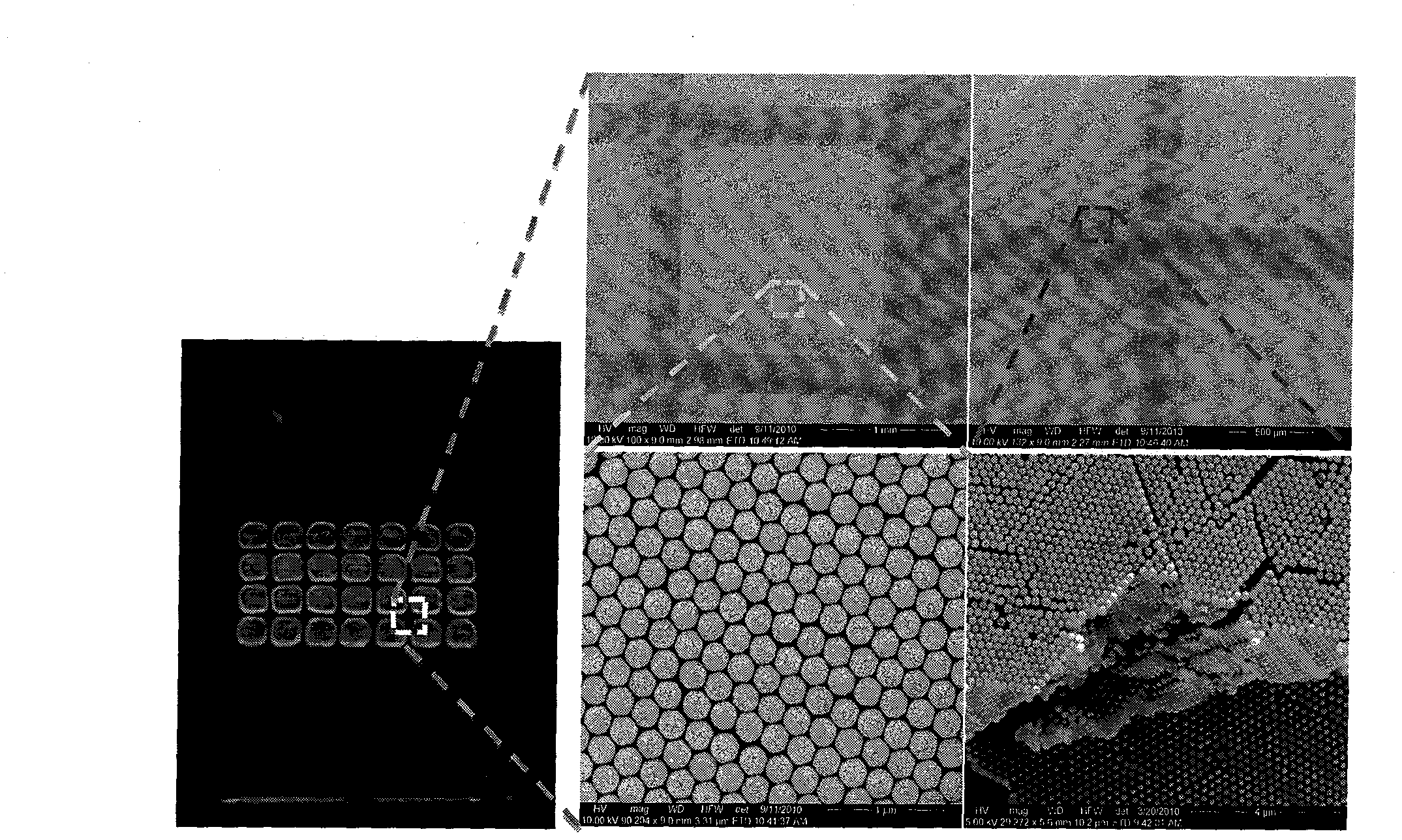Universal and efficient photonic crystal microchip for detecting multiple substrates
A photonic crystal and microchip technology, used in fluorescence/phosphorescence, material excitation analysis, etc., can solve the problems of reducing detection limit and increasing luminescence intensity, and achieves high detection density, simple process, excellent environmental friendliness and chemical economy. Effect
- Summary
- Abstract
- Description
- Claims
- Application Information
AI Technical Summary
Problems solved by technology
Method used
Image
Examples
Embodiment 1
[0037] 1) Select 4-pyrenyl-8-hydroxyquinoline as the chemical sensor, and measure the reaction of 4-pyrenyl-8-hydroxyquinoline on AlCl in tetrahydrofuran (THF) solution respectively. 3 , FeCl 3 , CoCl 2 , NiCl 2 , CuCl 2 , ZnCl 2 , HgCl 2 , CdCl 2 , CaCl 2 , MgCl 2 Fluorescence spectra of metal cation responses. (Such as image 3) According to the fluorescence spectrum characteristics of 4-pyrenyl-8-hydroxyquinoline metal cation response, photonic crystal arrays with forbidden bands at 390nm (near ultraviolet), 450nm (blue), 540nm (yellow) and 610nm (red) were selected to form an array. Detection analysis.
[0038] 2) Prepare polyacrylic acid-polymethyl acrylate (shell)-polystyrene (core) polymer nanoemulsion particles by block emulsion polymerization, and use surfactant (sodium dodecylsulfonate) to adjust and control the preparation Latex microspheres with different particle sizes (150-350nm).
[0039] 3) The photonic crystal latex microsphere emulsion with the fo...
Embodiment 2
[0047] 1) Select 8-quinolinol as the chemical sensor, and measure the reaction of 8-quinolinol on AlCl in tetrahydrofuran (THF) solution respectively. 3 , FeCl 3 , CoCl 2 , NiCl 2 , CuCl 2 , ZnCl 2 , HgCl 2 , CdCl 2 , CaCl 2 , MgCl 2 Fluorescence spectra of metal cation responses. (Such as image 3) According to the fluorescence spectrum characteristics of the 8-quinolinol metal cation response, photonic crystal arrays with forbidden bands at 390nm (near ultraviolet), 450nm (blue), 540nm (yellow) and 610nm (red) were selected for detection and analysis.
[0048] 2) Prepare polyacrylic acid-polymethyl acrylate (shell)-polystyrene (core) polymer nanoemulsion particles by block emulsion polymerization, and use surfactant (sodium dodecylsulfonate) to adjust and control the preparation Latex microspheres with different particle sizes (150-350nm).
[0049] 3) The photonic crystal latex microsphere emulsion with the forbidden bands prepared in step 2) at 390nm (near ultrav...
Embodiment 3
[0057] 1) Select dansyl-triethylenediamine as the chemical sensor, and measure the reaction of dansyl-triethylenediamine on AlCl in tetrahydrofuran (THF) solution respectively. 3 , FeCl 3 , CoCl 2 , NiCl 2 , CuCl 2 , ZnCl 2 , HgCl 2 , CdCl 2 , CaCl 2 , MgCl 2 Fluorescence spectra of metal cation responses. (Such as image 3) According to the fluorescence spectrum characteristics of dansyl-triethylenediamine metal cation response, photonic crystal arrays with forbidden bands at 430nm (blue), 480nm (cyan), 500nm (green) and 550nm (yellow) were selected for detection and analysis .
[0058] 2) Prepare polyacrylic acid-polymethyl acrylate (shell)-polystyrene (core) polymer nanoemulsion particles by block emulsion polymerization, and use surfactant (sodium dodecylsulfonate) to adjust and control the preparation Latex microspheres with different particle sizes (150-350nm).
[0059] 3) The photonic crystal latex microsphere emulsions with forbidden bands at 430nm (blue), ...
PUM
 Login to View More
Login to View More Abstract
Description
Claims
Application Information
 Login to View More
Login to View More - R&D
- Intellectual Property
- Life Sciences
- Materials
- Tech Scout
- Unparalleled Data Quality
- Higher Quality Content
- 60% Fewer Hallucinations
Browse by: Latest US Patents, China's latest patents, Technical Efficacy Thesaurus, Application Domain, Technology Topic, Popular Technical Reports.
© 2025 PatSnap. All rights reserved.Legal|Privacy policy|Modern Slavery Act Transparency Statement|Sitemap|About US| Contact US: help@patsnap.com



